
Get ready to start a measuring campaign
17/92
4.1 Soil samples
4.1.1 Take soil samples
Samples should be as fresh as possible. Please follow the guidelines
for taking soil samples (described in DIN 4021, “Exploration by
excavation and borings; sampling)
Following a short instruction for soil sampling based on lecture notes
from Prof. Dr. W. Durner:
Uncover the preferred soil level. This can be either vertical or
horizontal. Hammer in the ring by using a proper knock-on handle
and a medium size hammer. Hammer in straight and avoid tilting the
ring. Carefully excavate the ring with a knife or spatula. Now cut off
the overlapping soil along the ring’s rim with a very sharp knife - take
care not to smear the pores. Cover the samples with protective caps
for transportation. In general a minimum of 5 to 10 samples per soil
level are taken to determine the bulk density and the retention curve.
Weights of the sampling rings might vary. Therefore, it is essential
that the rings are specifically weighed.
4.1.2 Saturate the samples
Remove the protective cap from the upper side of the sample (the
side with the straight rim without cutting edge) and place the mesh
fabric on the sample.
Attach the perforated saturation attachment to clamp the cloth.
Turn around the sample and
remove the second plastic
cap.
Fill the dish with water and
place the sample in the dish,
standing on the perforated
attachment. The water level
should be 1 cm below the
upper rim of the sampling
ring.
The cutting edge shows
upwards, thus the sample is saturated from the reverse side.
Fig. 8: Dish with water and samples
The duration until the sample is saturated and all air is removed will
depend on the soil type. When saturated, the sample surface will
















































